Sovereign Debt Crisis: Investor Emergency Strategy Update
Stock-Markets / Financial Markets 2010 May 17, 2010 - 08:14 AM GMTBy: Martin_D_Weiss
 Martin Weiss: Just days ago, the cradle of Western democracy — Greece — was in flames! Rioters attacked banks, businesses and government buildings. The entire country plunged into chaos. Spain, Portugal, Italy and even the United Kingdom were reeling. The euro was crushed.
Martin Weiss: Just days ago, the cradle of Western democracy — Greece — was in flames! Rioters attacked banks, businesses and government buildings. The entire country plunged into chaos. Spain, Portugal, Italy and even the United Kingdom were reeling. The euro was crushed.
Then, as we have warned you consistently and persistently, the raging storm in Europe struck our shores … ripped through our corporate bond market … created chaos in our stock market … and threatened to derail our already-fragile economic recovery.
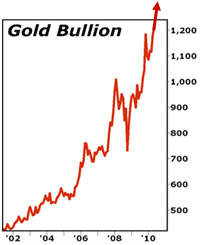 |
In response, Europe announced a trillion-dollar bailout while our own Federal Reserve issued a blank check to give Europe virtually any money it says it wants. And still the euro has plunged, while gold has soared to new highs! Still the crisis is not over!
All this is raising several urgent questions for investors.
First, does this new debt crisis mark the end of the big market rally since March of last year?
Second, how is the European debt crisis likely to impact your investments now and in the weeks ahead?
Third, when will this crisis hit Washington and what will they do next?
Fourth, how can you protect yourself no matter what Washington decides to do?
And fifth, gold! Gold has surged dramatically, even with the dollar rising.
How high might gold go if the dollar falls? Should investors add to their gold holdings now or wait for a correction? What about gold shares and other natural resources?
Sovereign Debt Crisis is Really a Currency Crisis!
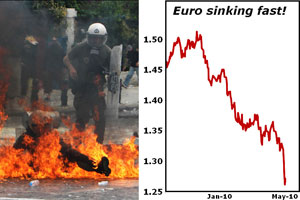 |
Larry Edelson: Hi Martin, I’m calling in from Asia, and every night, while you’ve been sleeping, I’ve been watching this crisis unfold in real time. So let me tell you what I see. The sovereign debt crisis is a currency crisis! And I’m worried it’s going to be a lot bigger than even I expected. The fact is Europe is sinking and the euro is crashing.
Martin: What about the trillion-dollar bailout of Europe?
Larry: It changes nothing. It means massive money printing and even more spending by bankrupt economies. The plunge in the value of their currency — any currency for that matter is the pivotal financial consequence of a sovereign debt crisis — the major consequence that we have been warning you about. I repeat: This is a CURRENCY CRISIS. Currencies are cornerstones — the stock — of a country.
This is an explosive crisis that can wipe out people’s wealth without them even knowing it. But it can also provide them with the broadest opportunities for profit. My primary goal today is to guide you in this crisis, to protect your wealth and to finding nice opportunities to profit from it.
Martin: Yes! But let’s start with the impact on global stocks, especially U.S. stocks. Mike?
Mike Larson: First of all, if you’ve been reading our alerts or you subscribe to our newsletters, you should not be loaded up with stocks. We’ve been warning about the dangers all along. Our cash positions are high. Despite low yields on cash, our primary concern has always been about the return OF your money — over and beyond the return ON your money.
Second, we have not been playing the stock market overall. We have been very cautiously and selectively recommending the unique stock sectors and foreign countries that have the fundamental power to endure before, during and after this crisis.
Martin: But that doesn’t protect you from market crashes.
Mike: No, of course not. For that, we use hedges and inverse ETFs. We also take advantage of rallies to pare down our positions
Martin: Some folks writing in have apparently not followed that conservative approach. They are loaded up. And they want to know what to do.
Larry: I want to jump in here about gold. I want to make it clear; I don’t believe investors should unload gold shares.
Martin: OK. My question to Mike is: If you’re overloaded — except with gold shares as Larry interjected — what specific steps do you recommend to unload excess positions?
Mike: A good rule of thumb is to sell half of your excess holdings now and then revisit the balance when you get a good rally.
But I do have a word of warning: Even when you get the rally, it is very easy to forget the crisis. Things may appear to have quieted down, but it’s really going to be just the next calm before an even bigger storm that is coming.
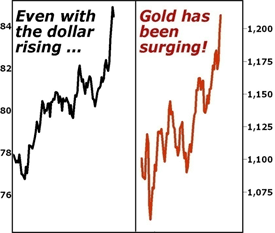 |
Larry: For gold it is a very different strategy. Gold is going up right now despite a rising dollar. It will go up even more when the sovereign debt crisis hits the dollar, and the dollar starts plunging like the euro is. I expect it to hit $1,300, then $1,500 and then ultimately to at least $2,300 an ounce.
So core gold holdings should be held no matter what, in my opinion.
Martin: What about in the short term?
Larry: There are going to be wild zigs and zags like we are seeing in all markets. Just never forget the sheer enormity of the sovereign debt crisis, which, again, is ultimately a currency crisis.
Mike: For many years, a handful of observers have been warning with a simple message: We can’t borrow and spend forever and get away with it. We warned. Others warned. But no one in the political or financial capitals around the world paid any attention. They laughed at us. They ridiculed us. Now that day of reckoning is here.
Martin: What’s so utterly deceptive about these events is that they can indeed get away with it for such a long period of time.
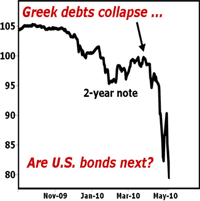 |
Mike: Yes, and Greece is the perfect example. For years, we knew Greece’s government was going wild with its spending, and some analysts warned about it until they were blue in the face.
But even amidst all the warnings, Greek government officials would go on TV and say: “What’s the problem? If we really were doing something wrong, we’d have trouble borrowing money. But look! We have hoards of investors buying our bonds. We can borrow as much as we want for less than 3%. So where’s the crisis?”
That continued year after year, until one day the party ended. No one rang any bells to warn them. No one single event triggered it. The worries and warnings that had been percolating for years just reached a critical mass and blew up. Suddenly, bond investors declared a virtual buyer’s strike. Suddenly, Greek bond markets collapsed. Suddenly, their interest rates were doubling and then doubling again.
Larry: A collapsing bond market goes hand in hand with a collapsing currency. Both are driven by the same government spending, borrowing and reckless money printing. Both are driven by the same global investors. When they sell euro-zone bonds, they sell the euro. If they sell U.S. dollars in denominated bonds they are going to be selling the U.S. dollar.
Look at this plunge in the euro — in just two or three weeks; it got smacked down from 1.36 to 1.25. That’s a massive, 8% decline — in just three weeks.
Martin: Only 8% that doesn’t sound like that much?
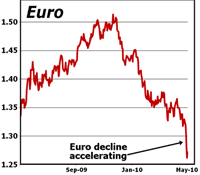 |
Larry: 8% in a currency change? Are you kidding? For a major currency? Remember, this isn’t just a single stock or stock market. It is the foundation of the European Union. It is their currency. It represents, in essence, the equity value of the economies of 16 countries, almost an entire continent.
If the decline continues at this pace, everything Europe produces or owns will lose half its value in about five months.
Connect the dots here. Look at this chart of gold. It is real money and has been that way for 5,000 years. As the euro is collapsing … gold, in terms of the euro, is going through the roof!
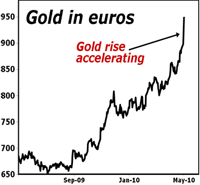 |
Martin: So what’s the lesson you want to take out of these charts?
Larry: In the past when the euro was falling so was gold. That is not happening now. Now, you have a bull market in gold in terms of ALL major currencies. So the lesson is: It doesn’t matter which major currency is crashing. They are all losing purchasing power. The key: If gold is rising in response to the euro’s decline, imagine what it will do in response to a collapse in the world’s reserve currency — the dollar!
The Next Big Domino
Mike: The dollar is the next big domino in this debt crisis. Look. Most people see this as a new debt crisis that just began this year. But it’s not. It’s the same debt crisis that began over three years ago with the housing bust. Governments in the western world went hog wild spending trillions to bail out their banks, their economies. They bought up trillions in toxic assets. They took over the crisis. And now they OWN the crisis. So it should come as no surprise that governments themselves are now the next targets of investor revenge — the next institutions that need bailouts!
Martin: This is precisely the sovereign debt crisis we warned about in our white paper submitted to Congress …
Mike: … when they were voting on the TARP bill to bail out the banks in September of 2008.
Martin: Now it’s here. This is it!
Mike: In Europe, yes. In the U.S., not quite. In the U.S. we still see the same syndrome as we saw in Europe just a few months ago. We see virtual clones of the officials and pundits we saw in Greece — but this time from Wall Street and Washington. And they’re saying almost exactly the same thing the Greek officials were saying last year: “Look,” they say. “We have tons of investors rushing to buy our bonds … and we can borrow as much as we damn please for less than 4%! So what’s the problem? Where’s the fire?”
Martin: I see the parallels. But it still begs the question, if the United States is in such grave danger, how come we don’t see our government bond markets tanking like Greek bonds have tanked?
Mike: Because the Western world is like the Titanic … because the U.S. bond market and dollar market, are like the stern of the Titanic.
Martin: Before the Titanic sank, the stern section was pulled up by the sinking bow. The stern actually rose up high out of the water.
Mike: Yes! And when we see a global flight to quality, we see everyone rushing to the stern — to the dollar and the U.S. Treasury market. They have the illusion that’s where they can find higher ground, safety. That’s why you see U.S. bond prices temporarily rising while the euro-zone bonds sink.
Larry: And why you see the dollar rising while the euro plunges. But there is not going to be any safety found in the stern of the Titanic.
Mike: As you know, Larry, countries from both sides of the Atlantic are in the same boat. Both the U.S. and Europe have all been spending like crazy for years. Both got hit by the housing bust and debt crisis. Both spent massive sums on bailouts and economic rescues. So as a result, both are loaded with debts they cannot possibly pay. And here’s the key: Both are vulnerable to the same contagion that has struck Greece and much of Europe.
Larry: But I talk to a lot of American investors who, like Wall Street and Washington, are still in denial. They don’t believe that our country has racked up the debt that we are talking about.
Mike: OK. Let’s prove it right now. Five euro-zone countries have more debt than they can possibly manage and are in danger of defaulting. But what most people do not realize is that the United States is in the same category. It is not different. It is not special. It is ultimately equally … or even MORE vulnerable. Consider these facts:
Spain, which just got downgraded, has 59.2 cents in debt per dollar of GDP. But the U.S. has far more — a whopping 94.5 cents on the dollar!
Martin: Our debt load is worse than Spain’s!
Mike: Much worse! And look at Portugal, which also was downgraded. It’s running a deficit that chews up 8.3% of its GDP. That’s way out of line. But the U.S. federal deficit is significantly worse — gobbling up a whopping 10.6% of our GDP. Even compared to Greece, America’s deficit level is only slightly less bad — 10.6% of GDP in the U.S. vs. 12.2% in Greece.
Larry: The U.S. is the leader of the global borrowing and spending rampage. It was ground zero of all the fiscal insanity. The U.S. government has the most domestic debts of all nations in the world — $127 trillion, including what it owes to its citizens in the form of Social security and Medicare. The U.S. has the most foreign debts of all nations in the world. So this makes you wonder …
Martin: Greece, Portugal, Spain and the other PIIGS countries supposedly have the IMF to fall back on. The IMF has Washington to fall back on. But who’s going to bail out Washington?
Larry: The answer is that there’s nobody left to save America, and the American taxpayer is going to take the brunt of it. We are the world’s richest nation. We are the safety net of last resort. When America’s turn comes, Washington will have two and only two choices:
Choice #1: Simply walk away — default on the $12.6 trillion of national debt we owe to bond investors.
Martin: They’re not going to do that.
Larry: Of course not. But they will do it indirectly and that is Choice #2 — to print more money deliberately and devalue the dollar without coming out and saying they are doing it. They believe they can pay back their debts with a much cheaper currency.
Martin: Isn’t there also a third possibility — the possibility that they actually make massive, painful cuts in every major government program — including Social Security, Medicare and Medicaid — to bring the budget back into balance?
Larry: Can you imagine if Washington came out and said “We are going to cut Medicare and Social Security,” or “we are going to cut back on government pension guarantees”? Look at the riots in Greece!
Martin: One of our readers just wrote in saying the pundits have a hard time believing that this crisis will spread beyond the five PIIGS countries — Portugal, Ireland, Italy, Greece and Spain.
Mike: That’s the same b.s. we heard in the subprime mortgage crisis. Remember: That crisis did not start with the biggest dominos — Citigroup or Bank of America. It started with a core of small subprime lenders that were the highest risk offenders, and they ALSO said it could be “CONTAINED.”
Then, it spread outward from there, and at each step of the way, they AGAIN said it would be “contained.” Now, something similar is happening here. It started with the worst offender — Greece — and they said that could be contained. But you can see what the market judgment is — it has already started spreading to Spain’s bond market, to Portugal’s bond market and others, and they’re STILL saying it can be contained!?
If the UK and U.S. and other major countries were in great financial shape, sure. But they’re not. In many respects, especially in terms of our debts to China, Japan and others, we are actually in worse shape.
Larry: My view is that Bernanke is blinded by his theories of history. Geithner won’t listen. Obama is mute on the subject. They see, hear and speak no trouble. But I don’t care what they say about the differences between the U.S. and Europe. A broke government is a broke government. Period.
Martin: You’ve made your point, Larry. And so far you’ve been right. So let Mike and me ask you some tough questions we’re getting from readers. First, what’s next in your scenario?
Larry: A temporary rally in the euro is possible, followed by another collapse. Up until now, compared to our Federal Reserve, the European Central Bank has been pretty conservative. But now it’s going to have to get aggressive and follow the lead of the Fed. So it’s going to start printing money like crazy to fund the bailout for Greece and try to stop the contagion from rolling through the rest of Europe.
It already made a decision about a week ago to accept junk bonds as collateral on its debt, and it’s already printing more money. But all this is to no avail because Europe’s currency — the euro — has some unique, fatal flaws that are going to exasperate this crisis.
First of all, the euro is a rookie currency. It is an experiment that’s only 12 years old. In my opinion, the currency was created ass backwards. It was put in place without a unified constitution behind it.
Martin: The euro crumbles. Then what?
Larry: Next, the Federal Reserve will print more money to fund the money they’ve promised. It’s a desperate last-ditch stand to help defend the euro.
Martin: The Fed is now printing money to buy European bonds.
Larry: Yes. And as the crisis strikes our shores, the Fed will print even more money!
Martin: What happens in the end?
Larry: In the end, just like the euro currency plunged dramatically, the U.S. dollar will plunge dramatically. Both currencies will go down, although in different ways: The euro will fail as a currency or at least lose many of its members. And the dollar will lose its status as the world’s reserve currency.
Mike: A subscriber to your Real Wealth Report is asking:
“The dollar is the world’s ultimate safe haven, the world’s main currency. Doesn’t that protect it?”
Larry: It did when everything was going fine for the world. But in bad times, it’s likely to be terrible for the U.S., putting a huge, additional burden on our government and our people.
Look, I travel a lot and I can tell you that, in every corner of the globe, investors blame the U.S. for this whole crisis. The outcome is that everyone also looks at the U.S. to SOLVE the whole crisis. That means that a huge portion of the entire burden of the global debt crisis will ultimately fall on the U.S.
Martin: Can you sum up what’s driving gold higher?
Larry: Sovereign governments are broke. The public and investors are finally realizing it and acting on it. So governments are responding by printing money and by gutting their currencies.
Martin: One reader has asked:
“I heard somewhere that Larry recommended investors put only about 10% of their money in gold and then I’ve heard him say that the value of gold bullion could double or more. If gold is going that high, why only 10% in gold?”
Larry: I’m not sure where that 10% figure came from, because my standing position in my Real Wealth Report has been 25% of your total investable funds in gold.
Martin: In gold bullion?
Larry: No, not all in gold bullion. About half of the 25% — 12.5% — in gold bullion and gold bullion equivalents — like the SPDR Gold Trust ETF (GLD) — or other gold bullion ETFs.
Martin: How do you buy bullion?
Larry: First let me tell you how not to buy bullion. Two gold investments I recommend people avoid with a ten-foot pole are rare (1) coins and (2) commemorative coins which are being advertised in practically every newspaper and on every TV channel.
Martin: So what is the best way to buy gold bullion — other than an ETF?
Larry: The best way to buy bullion is in 1-ounce, 5-ounce and 10-ounce ingots plus kilo bars. You don’t have to pay the premiums you are paying on American Eagles or Canadian Mapleleafs.
Martin: That covers the first half of the 25%. What about the other 12.5%?
Larry: In mining shares!
Martin: Name three.
Larry: I actually have four I want to name today. And they are all cream-of-the-crop gold shares.
Goldcorp (GG) — one of my favorites — is the world’s second-largest gold producer, with nearly 49 million ounces in proven and probable gold reserves, which it’s producing at a cash cost of $295 an ounce.
Agnico-Eagle Mines (AEM) is a Canadian-based gold producer with just over 18 million ounces of gold — a fantastic company.
I have a mid-sized miner, Golden Star Resources (GSS), with just over 2.3 million ounces. It is not a very big player but it knows how to hunt down and add to its reserves.
Plus, one of my big favorites is Seabridge Gold (SA), an exploration company with just over 30 million ounces of gold in proven reserves. Golden Start reminds me of Royal Gold, which is up over 800% in the last nine years. Royal Gold did something unique, cutting royalty deals with miners to mine the property, and taking a royalty off the top.
Silver, Platinum and Palladium
Mike: Can we talk about silver? Many of my readers — and yours I presume as well — are saying they follow analysts who believe silver will outperform gold going forward. Can you throw some light on this?
Larry: I like silver. I am bullish on silver over the long haul. But I do not believe it will outperform gold. Silver is not a monetary metal; it’s an industrial metal. And this crisis is fundamentally, a monetary crisis. That’s the chief reason I’m not as bullish on silver.
Martin: What about platinum and palladium?
Larry: I prefer them over silver. They are far more in demand and in shorter supply.
Martin: You can buy GLD for gold, how can you play platinum and palladium?
Larry: The best way to play platinum is with the UBS E-TRACS Long Platinum Total Return ETN (PTM), which tracks the future prices of platinum. And the best way for palladium is the Physical Palladium Shares ETF (PALL), which tracks the futures price of palladium.
Martin: Do you recommend buying them right now?
Larry: No. Platinum was recently at a record high and same with palladium. I’d wait for a correction. Those markets have been on fire and are likely to pull back. You want to buy them near the end correction. Same thing for gold, if you are not in the gold market right now I would recommend holding for a little bit and waiting for the next correction.
Gold Stocks in a Crash?
Martin: Here’s another frequent question from readers:
“I understand how gold can be a good investment if paper currencies are getting clobbered. But if the scenario you are forecasting pans out, could it also have a negative impact on stocks? Why would mining stocks, or for that matter energy and other natural resource stocks, not be negatively impacted?”
Larry: I never said they wouldn’t be. In the initial panic of a crisis, investors dump everything. But that will not last. You need to hold your core position in gold during this monetary crisis as the value of paper money is getting destroyed.
Martin: What are your favorite energy plays?
Larry: Oil is not as pure as gold, but it’s similar in that it’s also a contra-dollar play. My forecast for oil is that it will go over $100 by next year and move higher as the dollar goes down.
As with gold, I like the big blue-chip energy companies: Chevron, Sinopec, ExxonMobil. These are going to be good investments and they’re going to be revalued higher when the dollar goes lower. Meanwhile, China’s first quarter oil demand was up some 9.6% over last year.
Martin: How else would you tell us to play the Chinese economy?
Larry: You need to be aware that although the U.S. and China economies have almost decoupled, the American and Chinese stock markets have not. When people panic, they tend to do it all over the world. If the U.S. market falls, so will China’s — but only temporarily.
My favorite China plays: Sinopec (SHI), which I mentioned earlier, one of the leading oil and energy companies in China.
There is the FTSE/Xhinhua China 25 (FXI) should be held to take advantage of a very long-term bull market in China.
And a very interesting company doing well with copper is Jiangxi (JIXAY). China is the world’s largest importer of copper.
Two Basic Strategies
Martin: Overall, what is your strategy going forward right now?
Larry: I have two strategies:
I have a core portfolio strategy with cream-of-the-crop natural resource companies, cream-of-the-crop contra-dollar real wealth tangible asset type companies — precious metals and energy — to be held in the next five years. I expect them to be substantially higher in the next five years.
Plus, I have a shorter term trading strategy for trading the swings in both directions — with more leverage and in a short burst of time.
Martin: Talk about swings! The price of oil went from $10 a barrel to $147 a barrel, a fifteen-fold increase, and then plunged to around the 30s and then back to mid $80 area. Is this a good thing or bad thing?
Larry: From a trader’s point of view, it’s fantastic — big moving swings can be great for making money.
Martin: And if you don’t like big swings?
Larry: If you don’t like the big swings, there are other natural resource assets that are also contra-dollar plays that are good for this kind of crisis. I’m talking about food and water — basic, essential consumer staples.
This investment news is brought to you by Money and Markets. Money and Markets is a free daily investment newsletter from Martin D. Weiss and Weiss Research analysts offering the latest investing news and financial insights for the stock market, including tips and advice on investing in gold, energy and oil. Dr. Weiss is a leader in the fields of investing, interest rates, financial safety and economic forecasting. To view archives or subscribe, visit http://www.moneyandmarkets.com.
© 2005-2022 http://www.MarketOracle.co.uk - The Market Oracle is a FREE Daily Financial Markets Analysis & Forecasting online publication.



